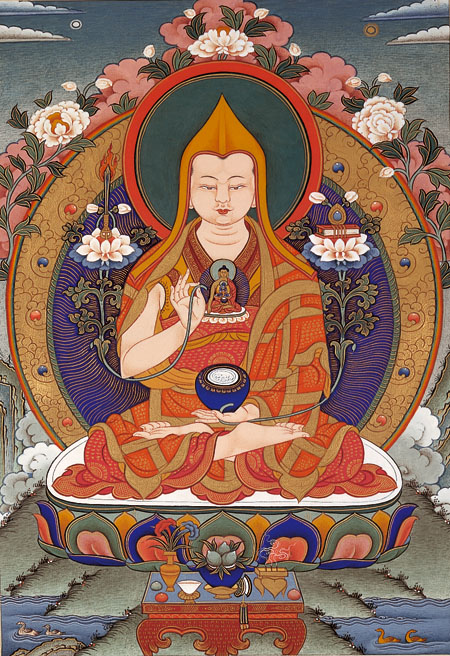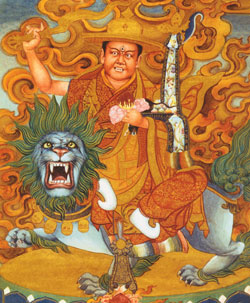
Lama Lobsang Tubwang Dorje Chang
Dorje Shugden and the Deities of his mandala are the same nature as the Deities of the body mandala of Lama Losang Tubwang Dorjechang, who is in essence Je Tsongkhapa.
After Je Tsongkhapa passed away, Khädrubje received five visions of him, each time appearing in a different aspect. Later, the great Yogi Dharmavajra saw Je Tsongkhapa in the aspect of Lama Losang Tubwang Dorjechang.
This name was given to Je Tsongkhapa by Manjushri. It indicates that Je Tsongkhapa is the embodiment of both Conqueror Vajradhara and Buddha Shakyamuni. ‘Losang Dragpa’ is Je Tsongkhapa’s ordained name, ‘Tubwang’ or ‘Powerful Able One’ is an epithet of Buddha Shakyamuni, and ‘Dorjechang’ is Tibetan for Vajradhara.
Lama Losang Tubwang Dorjechang is an enlightened being and the principal Field for Accumulating Merit in the Guru yoga of Offering to the Spiritual Guide, or Lama Chöpa.
In reality the Lama Chöpa instruction comes from Manjushri’s Emanation Scripture, which includes special instructions on Mahamudra. The Emanation Scripture, which cannot be read by ordinary beings, was revealed directly to Je Tsongkhapa by Manjushri.
It was passed down to successive lineage Gurus and when it reached the first Panchen Lama, Losang Chökyi Gyaltsän, he extracted the instructions on Lama Chöpa and the Root Text of the Mahamudra, the Main Path of the Conquerors and wrote them down in Tibetan. This was an act of great kindness because it meant that for the first time ordinary beings could read and practise Lama Chöpa and the special close lineage of Vajrayana Mahamudra.
The Guru yoga of Lama Chöpa is one of the most blessed practices within Je Tsongkhapa’s tradition, being the essential preliminary practice for Vajrayana Mahamudra. An extensive commentary to this practice can be found in Great Treasury of Merit.
There are thirty-two Deities within the body mandala of Lama Losang Tubwang Dorjechang, and it is these Deities who manifest as the thirty-two Deities of Dorje Shugden’s mandala. This was explained by Je Phabongkhapa, an emanation of Heruka, in his prayer to Dorje Shugden:
The aggregates, elements, sources, and limbs of Lama Losang Tubwang Dorjechang appear in the aspect of the five Lineages of Dorje Shugden and their retinues. Realizing that in reality I am practising the yoga of the thirty-two Deities of the body mandala, I offer this practice to you, O five lineages of Dorje Shugden; please accept it with delight.
Of the Deities of the five lineages of Dorje Shugden, the principal Deity is Duldzin Dorje Shugden. He is a manifestation of the aggregate of consciousness of Lama Losang Tubwang Dorjechang.
Vairochana Shugden is a manifestation of the form aggregate of Lama Losang Tubwang Dorjechang, Ratna Shugden is a manifestation of his aggregate of feeling, Päma Shugden is a manifestation of his aggregate of discrimination, and Karma Shugden is a manifestation of his aggregate of compositional factors.
Many sadhanas of Dorje Shugden state that Dorje Shugden is the embodiment of the ‘Guru, Yidam, and Protector’. Here, ‘Guru’ refers specifically to Lama Tsongkhapa. Thus, when we practise the sadhana of Dorje Shugden we are indirectly practising the Guru yoga of Je Tsongkhapa, as well as the practices of Yamantaka and Kalarupa.
Atisha said, ‘You Tibetans rely upon hundreds of Deities but do not achieve even one attainment, whereas we Indian Buddhists rely upon only one Deity and achieve the attainments and blessings of hundreds of Deities.’ We should bear Atisha’s comment in mind and realize that it is much more meaningful to practise one Deity sincerely, regarding that Deity as the synthesis of all Deities, than it is to practise many Deities superficially.

Dorje Shugden – an emanation of Manjushri
Some people believe that Dorje Shugden is an emanation of Manjushri who shows the aspect of a worldly being, but this is incorrect. Even Dorje Shugden’s form reveals the complete stages of the path of Sutra and Tantra, and such qualities are not possessed by the forms of worldly beings.
Dorje Shugden appears as a fully-ordained monk to show that the practice of pure moral discipline is essential for those who wish to attain enlightenment. In his left hand he holds a heart, which symbolizes great compassion and spontaneous great bliss, the essence of all the stages of the vast path of Sutra and Tantra.
His round yellow hat represents the view of Nagarjuna and the wisdom sword in his right hand teaches us to sever ignorance, the root of samsara, with the sharp blade of Nagarjuna’s view. This is the essence of all the stages of the profound path of Sutra and Tantra.
Dorje Shugden rides a snow lion, the symbol of the four fearlessnesses of a Buddha, and has a jewel-spitting mongoose perched on his left arm, symbolizing his power to bestow wealth on those who put their trust in him. The single eye in the centre of his forehead symbolizes his omniscient wisdom which perceives directly and simultaneously all past, present, and future phenomena. His wrathful expression indicates that he destroys ignorance, the real enemy of all living beings, by blessing them with great wisdom; and also that he destroys the obstacles of pure Dharma practitioners.
Each of the thirty-two Deities of Dorje Shugden’s mandala has a specific function, which are explained in a prayer written by Sachen Kunlo, one of the great Sakya Lamas.
In this prayer he explains that the function of Duldzin Dorje Shugden, the principal Deity of the mandala, is to lead faithful followers to correct spiritual paths by bestowing great wisdom; the function of Vairochana Shugden is to help us to pacify our negative karma and obstacles; the function of Ratna Shugden is to help us to increase our good fortune, lifespan, and virtuous realizations; the function of Päma Shugden is to help us to control our own mind so that we can help others achieve controlled, calm, and peaceful states of mind; and the function of Karma Shugden is to overcome the four maras and evil spirits who try to harm faithful disciples.
The nine Great Mothers help faithful followers of Dorje Shugden in their Tantric practices, the eight Fully-ordained Monks help them in their practices of Sutra, and the ten Wrathful Deities aid them in their various daily activities. In these spiritually degenerate times Dharma practitioners experience many obstacles, but if we rely upon Dorje Shugden with unwavering faith he will care for us just like a father caring for his children.
In general, all Buddhist practitioners need to develop unwavering faith in Buddha Shakyamuni, for without it their Dharma practice will have little power and bring few results; and in particular all Gelugpa practitioners need to develop firm and lasting faith in Je Tsongkhapa, otherwise they will never experience the unique qualities of his doctrine. Faith is the very root of all Dharma experience.
Gelugpa practitioners who have a sincere trust in Dorje Shugden will have no difficulty in generating unshakeable faith in Je Tsongkhapa. Their practice of view, meditation, and action will naturally become pure and they will easily realize the special uncommon qualities of Je Tsongkhapa’s teachings. Thus they will be able to gain experience of the stages of the path of both Sutra and Tantra without any difficulty.
Source: Tharpa Publications / Wisdom Buddha Dorje Shugden website, 2008
http://wisdombuddhadorjeshugden.org/dorjeshugden-nature.php







































 English
English Indonesia
Indonesia Tibetan
Tibetan